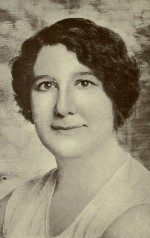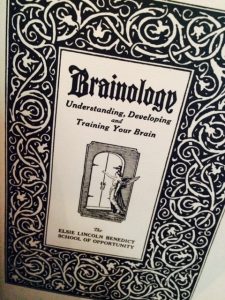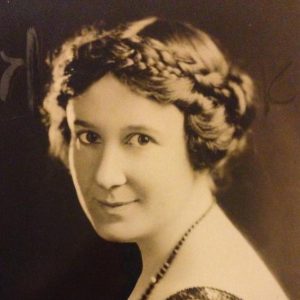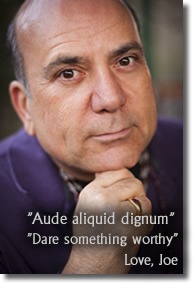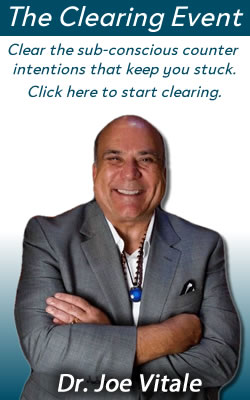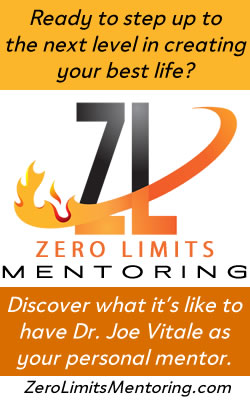Tag: dale carnegie
Forgotten Wonder Woman
Elsie Lincoln Benedict.
Recognize her name?
Neither did I until I found a copy of her 1928 book, Brainology.
Turns out this remarkable woman was the most popular self-help author in the world in the 1920s – seen by over three million people during her lifetime – before radio, television, and of the course the Internet.
The only person maybe more well known as a speaker was the former athlete turned fiery evangelist Billy Sunday. (I’ll pause while you Google him.) But even his extreme popularity shrunk in the 1920s as Else’s grew.
Elsie was an American suffragist leader, international lecturer, and popular author on psychology, self-improvement, and more.
She created and ran the Benedict School of Opportunity and founded The International Opportunity League, a book and correspondence business.
She traveled the world with her husband, Ralph Benedict, visiting at least 55 countries, and wrote about their adventures in a popular book, Our Trip Around the World.
She was born in 1885.
She was a millionaire by 1920.
This amazing woman wrote numerous books, such as Practical Psychology (1920), and with her husband, Unlocking the Subconscious (1922), How to Make More Money (1925), and their standout bestseller, How to Analyze People on Sight (1921).
I found Brainology: Understanding, Developing and Training Your Brain, and couldn’t believe it was written in 1928 but as useful today as it was when it first came out. She was way ahead of the modern fields of positive psychology and neuroscience.
Who was Elsie?
Apparently she was a cutting-edge leader, a petite woman with a commanding presence and charming personality, speaking and writing on what Napoleon Hill and Dale Carnegie and a long list of men would do later.
In many ways, while Elsie was just as upbeat as Hill or Carnegie, and just as subtly metaphysical, she was more practical. She gave people the nuts and bolts of how to succeed by teaching them practical psychology.
Hers was a common sense approach to a happy, healthy, prosperous life.
And she championed women’s rights.
She spoke — in the 1920s, remember — on such topics as Sex Psychology, How to Choose a Mate, How to Get Anything You Want, How to Succeed in Business, and more.
In 1922 she told an audience, “Most people use less brains in selecting the person with whom they are to spend their lives than they do in choosing an automobile, a bicycle or a cut of steak. Love isn’t enough; there must also be understanding.”
She made money even during the Great Depression. Her talks (usually free) inspired people. She urged them to think right, take action and take care of themselves. She also wrote, Outwitting the Depression.
She believed in the “work cure,” which was a new way to handle nervousness and hysteria and other psychological problems of the early 1920s.
The idea was to get you to do useful activities, like taking a college class, learning carpentry or music, or running an office.
The “cure” for what ails you was in the “work,” or the doing, of something meaningful.
Instead of disconnecting from life, you re-connected to life.
In 1923, the Oakland Tribune called Elsie “Wonder Woman,” explaining that “..she actually MAKES OVER THE LIVES of those who follow her wonderful, powerful teachings.”
When Elsie was asked, in 1920, how she attracted 3,000 people at a time to her talks, with hundreds being turned away due to lack of room, she replied, “Because I talk on the one subject on earth in which every individual is most interested – himself.”
I got so excited discovering Else that I went looking for more of her books. I found a pristine 1920 edition of Practical Psychology.
What a treat!
I was impressed at how her clear, direct, conversational writing style communicated practical insights about everything from how to stop worrying, how to build self-confidence, to how to make money.
I of course jumped to the How to Make Money chapter, which was the last one in the book.
Knowing all her readers would do what I did, there’s a line in parenthesis in that chapter where she says, “You are reading this chapter first!”
Elsie knew people.
While I haven’t seen her use the phrase “Law of Attraction” – yet, as I haven’t read all of her books yet – she certainly knew the power of the mind to direct action, which attracted results.
In that last chapter in Practical Psychology she writes:
“All men and women who have climbed to the top of life’s ladder climbed up mentally first.”
When her husband died in 1941, Elsie withdrew from public life.
She was heart broken.
She stayed plugged into life by traveling and visiting family.
But her public appearances and books were over.
She died in 1970.
I’m glad I discovered her.
She was one of those pioneers who paved the way for many others, including me and other Law of Attraction authors, by stepping forth in courage to share her message of self-help and self-improvement.
“Make a rule to dwell on nothing but the strong and good in life and people.”- Elsie and Ralph Benedict, Brainology, 1928
Thank you, Elsie.
I love you.
Ao Akua,
Joe
PS — Heather Mickelson, Else’s great granddaughter, is bringing the “forgotten wonder woman” back into public awareness by reissuing her lost books, writing a biography, and carrying her work into the modern age with humanitarian efforts. Heather’s site explains it all. See http://www.elsielincolnbenedict.com/
Best Books 2014
Reading as much as I do, it’s hard to narrow the stacks of great books down to a handful of memorable classics. Here are the top ten books that really stood out and made a difference in my life in 2014:
Best Books 2014
You Are a Badass by Jen Sincero. This may be my favorite book of the year. Yes, there are plenty of self-help books that say virtually the same thing as Sincero’s book, but almost none do it with attitude. I love the humor, honesty, intimacy, personality, and daring of the author. I love the book so much I reached out and interviewed Sincero for my podcast. She’s sincere, funny, open, and a living badass of the polite I-won’t-hurt-you but I’m-going-for-my-dreams-so-stand-back sort. Fun, wise, empowering. Read it.
Spartan Up! by Joe De Sena. This one lit a fire under my butt and made me want to get out and run up steep hills with my shoes on fire. Since I’m already working out intensely, thanks to personally training with Body-for-Life fitness legend Bill Phillips, I didn’t feel compelled to enter a Spartan endurance race. But I found this book inspiring, motivating, and heart pounding. I love his concept of “obstacle immunity,” which means hard core exercise builds inner strength to easily handle the stresses of normal life. He’s right. After intense exercise, traffic is nothing. Great book.
The Science of Living by Emmet Fox. This book clearly explains the teachings of New Thought pioneer Emmet Fox, most famous for his little books, such as The Mental Equivalent and Make Your Life Worthwhile. Though Fox taught and published in the 1930s, The Science of Living is a recent publication based on his private classes with metaphysical students. I love its clarity, plus it made me feel like I was in the room with him. This fully explains what the philosophy of Mind Science is all about. A true gem.
How to Win Friends and Influence People by Dale Carnegie. I’ve read this 1937 classic before, of course, but after reading a recent biography of Carnegie (Self-Help Messiah), I decided to read it again. It is a masterpiece. I am in awe of Carnegie’s conversational writing style, powerful stories, and crisp message. I wish just one of my books was this good. The message, while simple, is as relevant today as it was over the last several decades. Priceless.
Making the American Body by Jonathan Black. I found this book hypnotic. It masterfully tells the story of the men and women who shaped fitness in the United States. That may sound boring to you but believe me, the feats, feuds, and fuss of the often egomaniac men and women who urge us to get fit is an entertaining, enlightening, and even appalling read. My only disappointment is the author somehow left out Bill Phillips, who is a living legend in fitness. Otherwise, riveting.
A Moment in Time: The Steve Reeves Story by George Helmer. I’m one of the biggest Reeves collectors in the world. I have the famous body builder/movie star’s gym, car, clothes, trophies, and more. My collection is impressive enough that Lou Ferrigno (The Hulk) came to see it. This long awaited biography, by Reeves’ personal friend and executor of his estate, is mesmerizing. The hundreds of photos are worth the price of admission alone. The stories are alive. It’s a loving tribute to a legend; the definitive biography of the original Hollywood Hercules.
The Devil’s Horn by Michael Segell. As you may know, I’m now a saxophone player. (Afflatus, my baritone sax album, came out last month.) This is the hands-down best book ever written on the dramatic roller-coaster history of the sax, an instrument once considered the “devil’s horn” by some while others swooned to its cool sound. It was once the most popular instrument in the world (until the guitar got plugged in). The man who invented the sax – named (no surprise) Adolphus Sax – went through business failure, ridicule, controversy, political manipulation, envy, and even a death threat. An astonishing book.
The Practice of the Presence of God by Brother Lawrence. Nicholas Herman, later known as Brother Lawrence, lived in France in the 1600’s as a kitchen working monk. He dedicated his life to constantly living, working, playing, and praying “as in His presence” at all times. “His” means God. If the God word pushes a button in you, exchange it for Divinity or something else. This little book of conversations with, and letters by, Brother Lawrence has been changing lives for centuries. It did mine, too, and deeply influenced the writing of my forthcoming book, The Secret Prayer. There are numerous editions of this holy work around, many published in English for the first time around 1895. Highly recommended.
Managing Thought: How Do Your Thoughts Rule Your World? by Mary J. Lore. I love the direct simplicity of this well crafted book. It helps you understand what your thoughts are doing, whether you are aware of them or not. Of course, once you are aware of your thoughts, you are now separate from them and more in control. A practical, inspiring guide.
Willpower: The Owner’s Manual by Frank Martela. This brief book surprised me with the 12 tools it describes for “doing the right thing.” I expected fluff, I got wisdom. People often resist will power, thinking it is pure ego or pure pain, when in reality will power is what you often need to align your desires, achieve your intentions, and attract what you want. Great book. Will yourself to read it.
And here’s a bonus title —
You Are the Placebo by Joe Dispenza. I’m not a fan of so-called scientifically based books describing how the world works, mostly because I can’t follow their terminology and the authors often disagree with each other, but this book is easy reading, easy to understand, and truly eye opening. Dispenza explains how it is possible to heal many “incurables” with thought alone, by detailing how the mind influences everything. In a way, this is a manual on how to create the placebo effect as needed. I read every word. Fascinating.
What about you?
What did you read this year that moved you?
Please post your comment below.
Thank you.
Ao Akua,
Joe
PS – My list of best books for 2013 is at http://blog.mrfire.com/best-books-of-2013/

